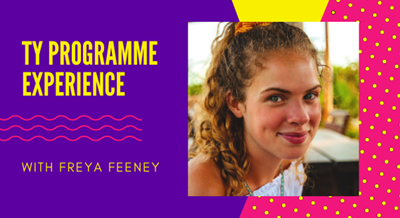
A student from a school in Dublin 8 explores how they learned about mental health by taking part in our Transition Year Programme.
Lilas Bailey from St Patrick’s Cathedral Grammar School in Dublin 8 took part in our Transition Year (TY) Programme and went on to become a mental health ambassador in her school. Here, she shares her experiences.
Mental health in our school
In 2021, my school was awarded as winner of the Best Programme Activity in the Walk in My Shoes (WIMS) Mission Possible school achievement awards. This programme was later shared in a newsletter to all primary and post-primary schools in Ireland. I was then selected for the TY Programme, which allows students to focus on various mental health issues and raise awareness about mental health. I will give a brief reflection of my experiences with the TY Programme and my school’s mental health activity below.
In preparation for TY work experience and to learn about how to get involved in projects, I entered an application for the TY Programme that was posted by my guidance counsellor. I was incredibly lucky to have won the draw and to have gotten a place in the WIMS programme.
Unfortunately, due to COVID-19, we could not complete the programme in person, but I still found it remarkably interesting and enjoyable, even online. During the programme, I learnt the structure and organisation of various positions within St Patrick’s Mental Health Services (SPMHS). We were taught about Dean Swift, who founded SPMHS, and his vision for what mental healthcare could look like.
Talks were given by several different people: some worked in mental health and explained their jobs, while others were past users of the services that SPMHS offers. The service users talked us through their mental health journey, and we also learned from others who were young carers (young people who have or had to care for a parent with mental or physical difficulties).
I found it so interesting to hear about everyone who benefits from and works with SPMHS. I learnt many new things, like the fact that people who use the services are not referred to as “patients” but “service users” and how MDT meetings take place (MDT stands for “multidisciplinary team”). These meetings are used to discuss how to best improve the mental health of a service user. The team is made up of a psychologist, a pharmacist, a social worker, and some other positions that you might not expect, like a physiotherapist. Later in the week, we were put into online breakout rooms and got to create and present our ideas for what a future mental health visitors centre could look like.
After completing the programme, I became more interested in how I could bring what I had learned to school and I decided to become involved in my school's Amber Flag team. Recently, my peers and I worked alongside the guidance department of our school to create Health and Happiness Week 2022. During this week, we learnt how to take care of our minds and our bodies and took part in a Spinathon for the Cycle Against Suicide programme in which we raised €600.
Overall, I really enjoyed this programme. Before I completed it, I had little idea of the many possibilities and careers in the mental health sector. Even if I do not choose to pursue a career in mental health, I still learned many valuable things that will benefit me and give me more of an insight into how to help someone who might be going through mental health difficulties.
More from TY students
Continue to…
How I deal with peer pressure: a young person’s experience


